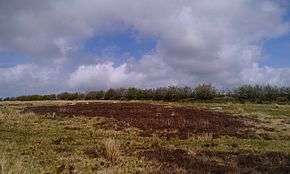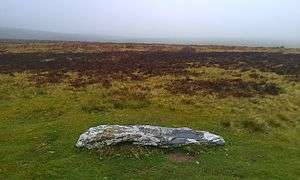Porlock Stone Circle
 The location of the circle in 2014; the stones are so small that discerning the site is difficult | |
 Shown within Somerset | |
| Location | Porlock |
|---|---|
| Coordinates | 51°11′22″N 3°39′14″W / 51.189549°N 3.653994°W |
| Type | Stone circle |
| History | |
| Periods | Neolithic / Bronze Age |
Porlock Stone Circle is a stone circle located near to the village of Porlock in the south-western English county of Somerset. It is found within Exmoor. The Porlock ring is part of a tradition of stone circle construction that spread throughout much of Britain, Ireland, and Brittany during the Late Neolithic and Early Bronze Age, over a period between 3,300 and 900 BCE. The purpose of such monuments is unknown, although archaeologists speculate that they were likely religious sites, with the stones perhaps having supernatural associations for those who built the circles. It has been scheduled as an ancient monument.[1]
Only two known stone circles were erected on Exmoor, the other being Withypool Stone Circle. In 1928 the site was surveyed and excavated by the archaeologist Harold St George Gray. A second excavation took place under the leadership of Mark Gillings in 2013.
Location
The circle is located two and three-quarter miles south-west of the village of Porlock.[2] It is also one mile south of the A39 road and is immediately to the west of the lane headed south to Exford.[2] The circle is at an altitude of almost 1,360 feet above sea level.[3] The circle is located six and a half miles north of the Withypool Stone Circle.[4]
The land on which the circle is located slopes from the north-east to the south-west.[3] From the circle, a range of different Bronze Age round barrows, or tumuli, are visible at different points in the surrounding landscape.[3] Among the nearest are Alderman's Barrow, Black Barrow, the two Bendels Barrows, the Rowbarrows, and the Kit Barrows.[5] On the east-northeast side of the circle is the Berry Castle earthwork camp.[6]
Context

While the transition from the Early Neolithic to the Late Neolithic—which took place with the transition from the fourth to the third millennium BCE—witnessed much economic and technological continuity, it also saw a considerable change in the style of monuments erected, particularly in southern and eastern England.[7] By 3000 BCE, the long barrows, causewayed enclosures, and cursuses which had predominated in the Early Neolithic had ceased being built, and were instead replaced by circular monuments of various kinds.[7] These include earthen henges, timber circles, and stone circles.[8] These latter circles are found in most areas of Britain where stone is available, with the exception of the island's south-eastern corner.[9] They are most densely concentrated in south-western Britain and on the north-eastern horn of Scotland, near Aberdeen.[9]
These stone circles typically show very little evidence of human visitation during the period immediately following their creation.[10] This suggests that they were not sites used for rituals that left archaeologically visible evidence, and may have been deliberately left as "silent and empty monuments".[11] The archaeologist Mike Parker Pearson suggested that in Neolithic Britain, stone was associated with the dead and wood with the living.[12] Other archaeologists have suggested that the stone might not represent ancestors, but rather other supernatural entities, such as deities.[11]

There are only two known prehistoric stone circles located on Exmoor: Withypool and Porlock Stone Circle.[13] The archaeologist Leslie Grinsell noted that there was a circular stone monument on Almsworthy Common that was "probably" also the remains of a stone circle,[14] although P. J. D. Way argued that it was a rectilinear stone setting, perhaps a series of parallel stone rows.[15] Archaeologists have attributed these circles to the Late Neolithic or Early Bronze Age,[16] and have noted that they are comparable to the stone circles found further south, in Dartmoor.[16] However, in contrast to the two known Exmoor circles, over seventy such monuments have been identified on Dartmoor.[17] This may be because Exmoor, unlike Dartmoor, has no natural granite.[17] Instead it has Devonian slates and Hangman Grits, both of which easily break up into small slabs, resulting in a general shortage of big stones on Exmoor.[17]
Exmoor also has a henge located near to Parracombe, although it has been damaged by ploughing.[17] Alongside this, the moor bears a profusion of other Bronze Age monuments, including between 300 and 400 round barrows, standing stones, and linear stone settings.[17] The creation of these different monument types might explain why so few stone circles were apparently created here.[18] Most of the surviving prehistoric stone monuments on Exmoor are located on those areas of moorland outside the limits of medieval and post-medieval agriculture. For this reason it is likely that the surviving sites are not a reliable indicator of the original extent of these sites.[16]
Description
The circle had a diameter of 80 feet and a circumference of approximately 252 ft.[5] The stones in the circle are green micaceous sandstone originating from the Devonian period.[19] These stones were probably collected in the local area.[19] Following his excavation of several stone settings, the archaeologist Mark Gillings argued that three forms of stone were deliberately incorporated into the article: small uprights, low uprights, and larger stones that are positioned in a sloping position.[20]
Investigation in the 1920s found ten upright stones and eleven prostrate ones,[21] and concluded that there would have probably been about forty-three stones in the circle, each spaced about six feet apart.[21] The largest gaps in the circle were on its north-west and east-southeast sides, where the stones may have been removed for use as road metal.[21] In 1950, it was noted that a number of the stones had since been disrupted by military training during the Second World War.[22] When the site was surveyed in 1989, thirteen stones remained in the circle,[23] a number of which were found to be in different locations to the 1920s.[23] A 2009 survey by the Exmoor National Park Authority found only ten.[23] A fuller archaeological investigation in 2013 revealed eighteen stones, eleven of which are upright and eight of which are fallen.[24] The archaeologist Mark Gillings noted that as it exists in the twenty-first century, the circle is "clearly an amalgamation of prehistoric and wholly modern standings stones".[25] Heritage managers therefore face a question as to whether they should remove the more recently-added stones or to accept these as part of the circle's on-going biography.[25]
Gillings argued that the stone row and cairn were part of a wider monumental landscape incorporating Porlock stone circle.[26]
During the 2013 excavation, a four-spoked lead wheel measuring 7 cm in diameter was found buried in the circle.[27] Although it could not be unequivocally identified, it resembled late Iron Age and early Roman votive items that are sometimes found in Britain and (more commonly) Gaul.[27] If this identification is correct, it would suggest that Porlock stone circle was known about and visited during the Romano-British period.[27]
Investigation
The circle was discovered by E. T. MacDermot, a man who lived in the Lillycombe estate near Porlock. He had been aware of several stones on Porlock Common but only noticed the wider circle after the heather was burnt away.[28] MacDermot was aware that the archaeologist Harold St George Gray had investigated Exmoor's Withypool Stone Circle in 1905, and informed him of the discovery.[29] In September and October 1928, Gray proceeded to survey the Porlock circle with the permission of the landowner.[30] He also briefly excavated a small area in the centre of the circle, where a dozen slabs of stone were revealed but no charcoal.[31]
In August 2009 a resistivity survey of the site was carried out by the archaeologists Mark Gillings and Jeremy Taylor of the University of Leicester. They did so at the behest of the Exmoor National Park Authority, who commissioned the research as part of their Monument Management Scheme.[32] This survey indicated that there had been sub-rectangular structures situated around the circle at some point in the past, although Gillings and Taylor acknowledged that excavation would be required to determine at what period these existed.[33]
Gillngs oversaw this fieldwork project in 2013.[34] His team opened a trench measuring 6 metres by 4 metres around the circle's northern arc.[35] Here, no artefacts from the original construction period were revealed,[27] and nor were any sealed, undisturbed deposits suitable for environmental sampling and dating.[36] A second trench was opened to examine a number of stones located to the east of the circle, which Gilling's team believed had been part of the stone row.[37]
References
Footnotes
- ↑ "Stone circle, Porlock Common". National Heritage List for england. Historic England. Retrieved 22 January 2017.
- 1 2 Burl 2005, p. 76.
- 1 2 3 Gray 1928, p. 72.
- ↑ Gray 1928, p. 71; Gray 1950, p. 87.
- 1 2 Gray 1928, p. 73.
- ↑ Gray 1928, p. 73; Gray 1950, p. 87.
- 1 2 Hutton 2013, p. 81.
- ↑ Hutton 2013, pp. 91–94.
- 1 2 Hutton 2013, p. 94.
- ↑ Hutton 2013, p. 97.
- 1 2 Hutton 2013, p. 98.
- ↑ Hutton 2013, pp. 97–98.
- ↑ Burl 2000, p. 150; Riley & Wilson-North 2001, p. 24; Gillings 2015, p. 1.
- ↑ Grinsell 1970, p. 38.
- ↑ Grinsell 1970, p. 41.
- 1 2 3 Riley & Wilson-North 2001, p. 24.
- 1 2 3 4 5 Burl 2000, p. 150.
- ↑ Burl 2000, p. 151.
- 1 2 Gray 1950, p. 87.
- ↑ Gillings 2015, pp. 26–27.
- 1 2 3 Gray 1928, p. 74.
- ↑ Gray 1950, p. 87; Gillings 2015, p. 4.
- 1 2 3 Gillings 2015, p. 4.
- ↑ Gillings 2015, p. 9.
- 1 2 Gillings 2015, p. 26.
- ↑ Gillings 2015, p. 27.
- 1 2 3 4 Gillings 2015, p. 19.
- ↑ Gray 1928, p. 71.
- ↑ Gray 1928, p. 71; Gillings & Taylor 2012, p. 197.
- ↑ Gray 1928, pp. 71–72; Riley & Wilson-North 2001, p. 23; Gillings 2015, p. 1.
- ↑ Gray 1928, p. 75.
- ↑ Gillings & Taylor 2012, p. 197.
- ↑ Gillings & Taylor 2012, pp. 198–199.
- ↑ Gillings 2015, p. 1.
- ↑ Gillings 2015, p. 10.
- ↑ Gillings 2015, p. 24.
- ↑ Gillings 2015, p. 20.
Bibliography
- Burl, Aubrey (2000). The Stone Circles of Britain, Ireland and Brittany. New Haven and London: Yale University Press. ISBN 978-0-300-08347-7.
- ——— (2005). A Guide to the Stone Circles of Britain, Ireland and Brittany. New Haven and London: Yale University Press. ISBN 978-0-300-11406-5.
- Gillings, Mark (2015). "Excavation and Survey at Porlock Stone Circle and Row, Exmoor". Proceedings of the Somerset Archaeological and Natural History Society. 158: 1–28.
- Gillings, Mark; Taylor, Jeremy (2012). "Geophysical Survey at Porlock Stone Circle" (PDF). Proceedings of the Somerset Archaeological and Natural History Society. 155: 197–199.
- Gray, Harold St George (1928). "The Porlock Stone Circle, Exmoor". Proceedings of the Somerset Archaeological and Natural History Society. 74: 71–77.
- ——— (1950). "Porlock Stone Circle, Exmoor". The Archaeological Journal. 107: 87–88.
- Grinsell, Leslie V. (1970). The Archaeology of Exmoor: Bideford Bay to Bridgwater. Newton Abbot: David and Charles. ISBN 978-0-7153-4953-3.
- Hutton, Ronald (2013). Pagan Britain. New Haven and London: Yale University Press. ISBN 978-0-300-19771-6.
- Riley, Hazel; Wilson-North, Robert (2001). The Field Archaeology of Exmoor. Swindon: English Heritage. ISBN 1-873592-58-2.
- Thom, Alexander; Thom, Archibald Stevenson; Burl, Aubrey (1980). Megalithic Rings: Plans and Data for 229 Monuments in Britain. BAR British Series 81. Oxford: British Archaeological Reports. ISBN 0-86054-094-4.
External links
| Wikimedia Commons has media related to Porlock Stone Circle. |
- Porlock Stone Circle at Pastscape
- Porlock Stone Circle at The Megalithic Portal
- Porlock Stone Circle at The Modern Antiquarian